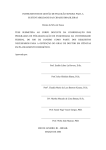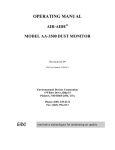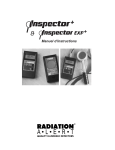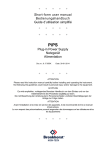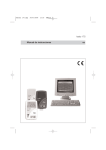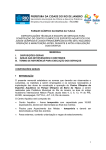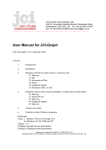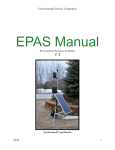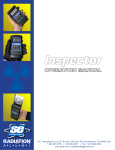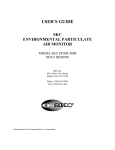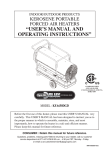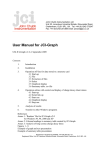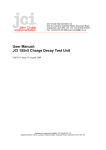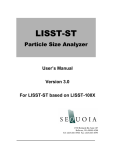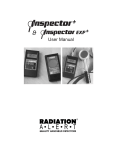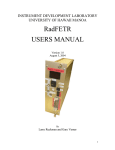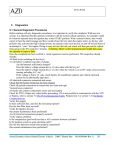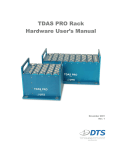Download HAZ-SCANNER™ Air Station Monitor
Transcript
HAZ‐SCANNER™ Air Station Monitor Model EPAS USER MANUAL For Windows and Mac Computers 2 Haz‐Scanner Manual 1109 Table of Contents Introduction -Getting Started Typographical Conventions ....................................6 System requirements................................................7 Installing the software..............................................7 Where to start............................................................7 Chapter 1 -Assembly Hardware Setup........................................................8 Mast Assembly - Permanent Installation................9 Mast Assembly - Portable Installation..................10 Instrumentation .....................................................15 Chapter 2 –Haz-Scanner Tutorial Introduction ............................................................22 Connecting to the Computer..................22 Zeroing the Gas Sensors.........................................23 Collecting A Data Set .............................................25 Uploading Data.......................................................26 Generating a Report ...............................................28 Chapter 3 -Using the Haz-Scanner Power Considerations............................................30 Turning on the Haz-Scanner................................31 Haz-Scanner Display Module......................32 Chapter 4 -Using the Haz-Scanner Software Connecting to the Haz-Scanner...........................35 Preferences ..............................................................35 Collecting Data .......................................................36 Viewing Data ..........................................................37 Uploading Data.......................................................38 Other Menu Items...................................................39 Environmental Devices Corporation * 4 Wilder Drive* Bldg 15* Plaistow NH 03865 Phone*603‐378‐2112 Fax* 603‐378‐2113 WWW.hazscanner.com 3 Haz‐Scanner Manual 1109 Viewing Data Files..................................................40 Plotting Graphs.......................................................41 Generating Reports.................................................42 Editing the Informational Text File.......................44 Printing Data and Reports.....................................44 Chapter 5 -Air Quality Basics Air Quality Information.........................................45 Sensor Characteristics and Modes of Operation..54 Chapter 6 –Troubleshooting Common Problems.................................................56 Technical Support...................................................56 Appendices Appendix 1 – Zeroing the Gas Sensors...........................................................................57 Appendix 2 – Calibrating the Haz-Scanner .............58 Appendix 3 – Haz-Scanner Data File........................59 Appendix 4 –Haz-Scanner Report ...........................60 List of Figures Fig. 1 – The Haz-Scanner .............................................8 Fig. 2 – Haz-Scanner Components..........................9 Fig. 3 – Securing the Lid Stays.....................................10 Fig. 4 – Mast Components ...........................................10 Fig. 5 – Correct Tripod Assembly ...............................11 Fig. 6 – Tightening the Mast to the Tripod.................11 Fig. 7 – The Wind Sensor in the Sensor Suitcase........12 Fig. 8 – Mounting the Wind Sensor ............................12 Fig. 9 – Adjusting the Compass to North...................13 Fig. 10 – Tightening the Thumbscrew ........................13 Fig. 11 – Mounting the System on to the Tripod ......14 Fig. 12 – Securing the Lid Stays...................................14 Fig 13 – Mounted Hand-held Meters..........................16 Environmental Devices Corporation * 4 Wilder Drive* Bldg 15* Plaistow NH 03865 Phone*603‐378‐2112 Fax* 603‐378‐2113 WWW.hazscanner.com 4 Haz‐Scanner Manual 1109 Fig. 14 – Sound Level Meter........................................18 Fig.15 15 – Atomic Fig. AtomicRadiation RadiationSensor..............................18 Sensor..............................18 Fig.16 16 –– Attaching the Temperature Temperature/RH /RHSensor.....19 Sensor.....19 Fig. Attaching the Fig.17 17 – Connecting theT/RH T/RHSensor.......................19 Sensor.......................19 Fig. Connecting the Fig.18 18 – Changing thePM PMImpactor...........................20 Cyclone............................20 Fig. Changing the Fig. 19 19 ––The Fig. TheImpactor..................................................21 Impactor..................................................21 Fig.20 20 – Removing Fig. Removing the theImpactor Impactor................................21 ................................21 Fig. 21 – Haz-Scanner Gas Sensors ...........................24 Fig. 21 – Haz-Scanner Gas Sensors ...........................24 Fig. 22 - Header Information Screen...........................28 Fig. 23 – Report Options Screen..................................29 Fig. 24 – Graph Options Screen...................................30 Fig. 25 – External Battery Supply................................31 Fig. 26 – InteliTender Battery Charger ......................31 Fig. 27– Rotary ON/OFF Switch................................32 Fig. 28 – Haz-Scanner Display Module......................33 Fig. 29 - Haz-Scanner Function Keys.........................34 Fig. 30 - The Summary Screen.....................................39 Fig. 31 -Limit Options Screen......................................41 Fig. 32 – Setting Custom Limits...................................42 Fig. 33 – Graph Options Screen...................................43 Fig. 34 – Report Options Screen..................................44 Environmental Devices Corporation * 4 Wilder Drive* Bldg 15* Plaistow NH 03865 Phone*603‐378‐2112 Fax* 603‐378‐2113 WWW.hazscanner.com Introduction – Getting Started The Haz-Scanner™ EPAS Air Monitoring System has been designed to provide accurate data through a simple, intuitive user interface. This manual will facilitate your ability to collect and analyze data with a minimum of effort. Don’t read manuals? Take a quick look at the Quick Start Sheet to get you up to speed quickly. Typographical Conventions The following conventions will make it easier for you to understand and use the features of the Haz-Scanner. command When you see text in this font, you should type exactly what you see into the computer. <data> You will type your specific data when you see this convention. You will be given instructions on what type of data is acceptable. Do not type the <>. NOTES are found interspersed among the text; they contain important information about the use of the system. TIPS are also provided to help you get the most out of the Haz-Scanner. These shortcuts will make you a more efficient user of the system. WARNING! It is important to read and understand all warning messages. Failure to do so can result in equipment damage. System Requirements At a minimum, your computer must have: Windows XP, or Mac OS X 10.1 or higher (with Classic Environment installed). Hard disk with at least 10MB (megabytes) of free disk space 10MB of RAM (memory) PC Only: 1 available COMM port (port used for connecting a serial device) Mac Only: Serial port to USB converter Installing the Software Insert the HazComm software CD into your CD drive. Extract zip files to the root\program files. The root drive on a windows computer is the C drive. After extracting the HazComm software, you will need to extract the uploads zip folder to your desktop. You may install the software on as many computers as you like. Double-click on the 'Read Me First.txt' file for more information. When you have finished installing the software, store the CD it in its case in a safe location. Where to start You may want to start by collecting a small amount of data and then generating a report. If you would like more guidance, turn to Chapter 2 and try the Haz-Scanner tutorial. If you are having problems, please contact technical support personnel who will be happy to get you up to speed. E-mail [email protected]. Chapter 1 – Hardware Setup In this chapter, you will learn how to assemble the system and how to collect data of interest to you. The complete system consists of standard and optional components. Standard sensors are Particulates (PM10 or TSP), VOC, Temperature, Relative Humidity, Wind Speed, and Wind Direction. Optional sensors are below. 1. Tripod assembly; optional accessory 2. Haz-Scanner EPAS 3. Optional Peripheral Monitors; Solar Irradiance, sound, atomic radiation, ELF or custom specific hand held’s. 4. Visual & audible alarm assembly optional HAZ‐SCANNER MODEL EPAS Tripod Assembly Picture of: EPAS fully assembled on tripod with sensors. Place lower mast in center of tripod. Note: Tighten all bolts securely Extend tripod base and mount solar panel bottom bracket to clamps on tripod. Secure backup battery mounting plate to tripod as shown. Place battery in plastic housing. Connect sensor cable to EPAS here Connect battery to solar panel. Note: All tripod bolts must be secure. Insert upper mast & secure sensors Wind speed, Solar, Rain sensor Mount EPAS holding bracket here. Extend upper mast & insert pin & tighten nut on lower mast. Mount solar panel clamp to tripod here Extend solar panel, extension bracket and secure to bottom Note: Solar panel must face south in direction at approximately 22‐30⁰ angle and free of obstruction or shade to reach maximum solar efficiency. C. INSTRUMENTATION Each Haz-Scanner system is manufactured according to the customer’s sensor specifications. Although individual systems may have different numbers of sensors attached, the software is self-configuring and determines which sensors are connected at any given time. NOTE: For data from any given sensor to be collected by the system, the sensor must be either connected or turned on before starting the Haz-Scanner system, or you must press the sense button on the display panel. You cannot connect and sense new sensors while datalogging. The table below lists the sensors that may be included in your Haz-Scanner. The status column explains what you will need to do in order for data to be collected from each sensor. Sensor Status Temperature / Relative Humidity Always ON Carbon Dioxide Always ON Carbon Monoxide Always ON Nitrogen Dioxide Always ON Ozone Always ON Oxygen Always ON Sulfur Dioxide Always ON Voc Always ON Wind Speed/Wind Direction Connect to turn on ELF Radiation Connect to turn on Ionizing Radiation Connect to turn on Sound Level Connect to turn on Solar Irradiance Connect to turn on Environmental Devices Corporation * 4 Wilder Drive * Bldg 15 * Plaistow NH 03865 Phone * 603‐378‐2112 fax * 603‐378‐2113 * www.hazscanner.com There is very little you need to know about the datalogger in terms of its operation. You won’t have to set up the sensors on any specific channels or provide any technical data about the sensors. The logger is self-configuring and all relevant calibration data and other technical specifications are stored in battery-backed memory before each unit is shipped. Turning the system on and off has no effect on this data stored in memory; however, calibration settings are reset to factory settings when the machine is powered off and on. Environmental Devices Corp. recommends annual factory calibration. Some of the sensors, most notably the ELF meter, Sound, and the atomic radiation detector, can be disconnected and used independently of the Haz-Scanner system. Of course, without being connected, these sensors will only display data on their built-in LCD displays; no data is stored in memory for later retrieval. These meters are turned on using their own switch and are powered by 9V replaceable batteries. See meter instructions for further information. Wind Speed and Direction‐ Standard Accessory The Wind Speed and Direction utilizes a rotary valve movement to measure both high and low air velocities. Other calibration configurations can be achieved by adjusting Haz‐Scanner programming‐consult Environmental Devices for further Instructions. 13 Haz‐Scanner Manual 1109 ELF Meter – Optional Accessory When used with the datalogger, the slide switch should be pushed down to measure ELF radiation in the 0 - 200 mG range. The ELF sensor utilizes a single-axis probe; before placing the probe at a given location, the probe must be oriented along each axis, X, Y, and Z, to determine the maximum reading and then left in that position for the duration of the logging session. See the PLM-100WB Instruction Manual for more information. NOTE: If the coiled probe cable is stretched at all, make sure you fasten the probe down somehow, or it may snap back and damage another sensor. A non-rechargeable 9V battery powers the ELF Meter. Sound Level Meter Optional Accessory This sound level meter has been designed to meet the measurement requirements of Safety Engineers, Health, Industrial Safety Offices and Sound Quality Control in various environments. This unit conforms to the IEC651 type2, ANSI S1.4 Type 2 for Sound Level Meters. [] Ranges from 30dB to 130dB at frequencies between 31.5Hz and 8KHz. [] Display with 0.1dB steps on a 4‐digit LCD. [] Two equivalent weighted sound pressure levels A and C. Note: Other calibration configurations can be achieved by adjusting Haz‐Scanner programming Consult Environmental Devices Corporation for further detailed Instructions. Atomic Radiation Meter (Geiger Counter) Optional A The top switch of this meter should be set to the middle position, counts per minute (CPM), for proper operation with the Haz-Scanner. Slide the bottom switch to the ‘ON’ position or to the ‘AUDIO’ position if you would like to hear a click each time the system records a count. Keep in mind that using the ‘AUDIO’ position will shorten the life of the internal non-rechargeable 9V battery. Environmental Devices Corporation * 4 Wilder Drive* Bldg 15* Plaistow NH 03865 Phone*603‐378‐2112 Fax* 603‐378‐2113 WWW.hazscanner.com Setting the Alarms 1) Turn on and start Haz‐Scanner 2) Connect serial cable to Haz‐Scanner and Computer. 3) Press connect button. 4) Select advanced tab. 5) In “type commands here” text box, type CV number for alarm you wish to change, follow by “=” and value you want the alarm to trigger. See below chart corresponding CV and sensor values. Sensor Alarm CV CO₂ 201CV CO 202CV NO₂ 203CV Particulates 204CV Relative Humidity 205CV SO2 206CV Temperature 207CV VOC 208CV Wind Direction 209CV Wind Speed 210CV Example: command 201CV=1000 (This corresponds to CO₂ gas will sound alarm above 1000ppm) 6) Press “Send Data” button. 7) Select Main Tab Note: Alarm will stay in memory until Haz‐Scanner is turned off. After turning off Haz‐Scanner you will need to repeat steps 1‐6 to set alarms. Particulate Matter (PM) Sensor The PM sensor with the Haz-Scanner has the capability to measure 4.0 micron 2.5 micron or 10 micron particle sizes. You will find a small cylindrical piece in the Haz-Scanner case. These are called impactors. You can change the particle detection size by physically replacing the PM impactor (Fig. 18 a, b). The PM10 impactor will detect a wider range of particle sizes than the PM2.5 impactor, or PM-4.0 impactor. Impactor sizes are labeled on the bottom of the Impactor. Impactor assembly Occasionally, you should remove and grease the impactor. The impactor is located inside the Impactor sleeve (Fig. 19). Remove Impactor by pushing up with pencil. (Fig. 20). Use just a small amount of Impactor grease. (P/N IG-105) Remove any excess before placing the impactor back into the sensor. The PM sensor has a self‐zeroing feature and cycles on every 30 minutes. You can tell when this is happening because the pump will sound different. The self‐zeroing operation takes a little under one minute. During this clean air purge, the sensor stores the last valid reading. Environmental Devices Corporation * 4 Wilder Drive* Bldg 15* Plaistow NH 03865 Phone*603‐378‐2112 Fax* 603‐378‐2113 WWW.hazscanner.com 16 Haz‐Scanner Manual 1109 Fig. 19‐ The Impactor Fig. 20‐ Removing the Impactor Carbon Dioxide Sensor The CO2 sensor is designed for measuring indoor air quality and will not give reliable data if the temperature is below 32° F. If you wish to measure outdoor CO2 concentration, keep the outdoor temperature in mind. Environmental Devices Corporation * 4 Wilder Drive* Bldg 15* Plaistow NH 03865 Phone*603‐378‐2112 Fax* 603‐378‐2113 WWW.hazscanner.com 17 Chapter 2 – Haz‐Scanner Haz‐Scanner Manual Tutorial Introduction This tutorial is designed to teach you the basic operations involved in using the Haz‐Scanner. After completing these exercises, you will be able to: • connect the system to a computer; • calibrate the gas sensors; • collect a data set; and, • generate a report, including graphs and explanatory text. To complete this set of exercises, you will need: • the Haz‐Scanner EPAS • Gas sensors have a gas scrubber to zero the sensors. • a computer with the HazComm software pre‐installed • a box of matches • a washcloth Connecting the HazComm Software to the Computer It doesn’t matter at what point in this process you turn on the Haz‐Scanner or the computer; you can make the connection first, or you can connect the two devices when either or both of them are on. If the Haz‐Scanner is off, turn it on by pressing the ‘Power’ red I/O button switch start button the power light on the Haz‐Scanner goes on, then release it. Power loss screen will appear, press any button to continue. WARNING! Ensure battery is fully charged before beginning air sampling. A fully charged battery will run the Haz‐Scanner for 8 hours depending on concentration levels and alarm conditions. To provide longer run time plug Haz‐Scanner into battery charger. For best results, turn on the Haz‐Scanner at least 1/2 hour prior to beginning this tutorial. 1. Connect the serial communications cable, to the RS‐232 port on the left side panel of the Haz‐ Scanner, to a serial port on your computer. On a PC, this port may be labeled ‘Comm 1’ or something to that effect. A PC will often have at least two Comm ports and you can configure the HazComm software to use either port or let the software figure it out for you. If you are using a Macintosh iMac, iBook, a newer PowerBook or a G4 tower or some PC’s may need to use a serial to USB adaptor, available at your local computer store or online. Environmental Devices Corporation recommends the Belkin USB Serial for Macintosh, Model F5U103‐MAC. The adapter is not required if you have an older Mac that has labeled printer and modem ports. More information can be found on the HazComm software manual. Environmental Devices Corporation * 4 Wilder Drive* Bldg 15* Plaistow NH 03865 Phone * 603‐378‐2112 Fax * 603‐378‐2113 www.hazscanner.com Gas Sensor Panel Fig. 21‐Sensor Panel Fig. 22‐Gas Sensor Panel 1. The sensors are labeled on the side plate of the EPAS. Gas sensors are located inside the sensor cover Fig. 22. Gas sensors are zeroed with purge scrubber to zero the gas sensors. 20 Haz‐Scanner Manual 1 Begin data collection by pressing function button and using ‘Up’ and ‘Down’ arrows finding log on. Then press checked button. Screen will display ‘Log On’ with arrows and red “!” light will be lit. Press function again to exit screen. 2 …..Scroll through the sensors until you come to display which says: Record Count 1 WARNING: Do NOT turn off the Haz‐Scanner prior to collecting data! The zeroing information is not saved permanently. DO remember to remove the zeroing plugs! Environmental Devices Corporation * 4 Wilder Drive * Bldg 15 * Plaistow NH 03865 Phone * 603‐378‐2112 fax * 603‐378‐2113 * www.hazscanner.com 21 Press I/O Start Button Haz-Scanner Display Module Environmental Devices Corporation * 4 Wilder Drive* Bldg 15* Plaistow NH 03865 Phone * 603-378-2112 Fax * 603-378-2113 www.hazscanner.com 22 Haz‐Scanner Manual Depending upon sensor configuration. This is a good way to see if the logger is working normally. 3. Using the ‘Up’ or ‘Down’ arrows on the display module, scroll through the sensors until you see ‘RH’ relative humidity. Note the value, Scroll down and also note the value of the temperature sensor. 4. Dampen the washcloth with hot water and place it near the back sensor panel where the temperature/relative humidity probe is located. 5. Note the temperature value, within a minute or two you should see it rise noticeably. After you see a change in the value of the temperature sensor, scroll up to the RH display. The relative humidity should also have risen noticeably. 6. Now exhale a few times on the CO2 sensor mounted in sensor panel. Scroll until you see the value of the CO2 sensor on the display. It should rise dramatically, since the CO2 concentration of exhaled breath is about 20,000 parts per million (ppm) and the ambient indoor concentration is often less than 1000 ppm. 7. Now we will cause the gas and particulates sensors to read higher values than normal. Light a match and hold it about two to three inches from each of the gas sensors. Gently blow the flame over each sensor. Blow out the match and blow the smoke near the particulate sensor. 8. Using the arrow keys scroll through each of the gas sensors and you will see, after a minute or two that the values have gone up. The particulates sensor will also register a noticeable gain. Uploading Data Press the function key and press the ‘down’ arrow key to find log off. Press the checked button and screen should go to log off with arrows and red “!” light will turn off. Refer to HazComm manual for uploading to HazComm software. Environmental Devices Corporation * 4 Wilder Drive * Bldg 15 * Plaistow NH 03865 Phone * 603‐378‐2112 fax * 603‐378‐2113 * www.hazscanner.com 26 Haz‐Scanner Manual 1109 Chapter 3 – Using the Haz-Scanner A. POWER CONSIDERATIONS Charge Battery for 14 Hours. The average battery power run time is 8 hours depending on concentration and alarm conditions. Environmental Devices Corporation * 4 Wilder Drive* Bldg 15* Plaistow NH 03865 Phone*603‐378‐2112 Fax* 603‐378‐2113 WWW.hazscanner.com 27 Haz‐Scanner Manual The Haz‐Scanner shuts off automatically when the internal battery voltage level falls below a preset value. At this time, data collection will cease in order to preserve data integrity. Data already collected will be saved. If this happens, you will need to connect the battery charger before retrieving the collected data. Furthermore, if you try to turn the system on and the main battery is below ~10.5 volts, the system will not turn on fully. Connect the charger immediately. When the external battery pack is plugged into the system the data collection time is quadrupled. Recharge this battery when not in use. B. TURNING ON THE Haz‐Scanner Monitor The system is turned on by pressing the red square I/O button and then pressing the red square start button. TIP: To avoid inaccurate data spikes near the beginning of your data file, it is important to warm up the gas sensors prior to the beginning of data collection. If this is not done, initial data will appear to indicate elevated levels of pollutant gases or the zero point will be incorrect and all data may be incorrect. Fig. 26‐ I/O Red square button is the start button TIP: To avoid inaccurate data spikes near the beginning of your data file, it is important to warm up the gas sensors prior to the beginning of data collection. If this is not done, initial data will appear to indicate elevated levels of pollutant gases or the zero point will be incorrect and all data may be incorrect. C. THE Haz-Scanner DISPLAY MODULE The display module, (Figure 26), allows you to control the functionality of the HazScanner. It contains five membrane key switches that, when pressed singly or in combination, allow the user to perform certain tasks described below. Environmental Devices Corporation * 4 Wilder Drive * Bldg 15 * Plaistow NH 03865 Phone * 603‐378‐2112 fax * 603‐378‐2113 * www.hazscanner.com 28 Haz‐Scanner Manual Figure 27 – Haz-Scanner Display Module Function Key The function key allows the user to toggle, log and off sensor and reset instrument. Edit Key The edit key allows the user to accept the commands. Environmental Devices Corporation * 4 Wilder Drive * Bldg 15 * Plaistow NH 03865 Phone * 603‐378‐2112 fax * 603‐378‐2113 * www.hazscanner.com Air Quality Parameters When evaluating outdoor air, the Haz-Scanner measures the same parameters as those measured by the EPA under the National Ambient Air Quality Standard promulgated by the Clean Air Act. In addition, other parameters, such as ultraviolet radiation, wind speed and wind direction, may be monitored. The indoor environment has become an issue of concern over the past several years with the advent of new construction techniques and building materials that severely restrict the exchange of indoor and outdoor air. This could have a deleterious effect on the quality of indoor air, and, therefore, the quality of life. *Many substances *effect the quality of the indoor environment. The Haz-Scanner, depending upon configuration, can quantify a number of key indicators of both indoor and outdoor air quality including: Atomic radiation; Barometric pressure; Carbon dioxide concentration; Carbon monoxide concentration; Extremely Low Frequency (ELF) radiation; Nitrogen dioxide concentration; Ozone concentration; Particulate concentration; Percent relative humidity; Sound level; Sulfur dioxide concentration; Temperature; and, Ultraviolet radiation. VOC Hydrocarbons Each of the EPAS parameters that appear in this report is discussed in detail below. Statistical summaries of the data collected are provided as an integral part of the program, and allow for data to be displayed graphically where applicable. Since it is difficult to display roughly 1500 data points at a time, an averaging technique is used to compress several minutes into one data point. This is why the first data point on a graph may not necessarily have the same value as that displayed after the first averaging period. The American Society of Heating, Refrigerating and Air Conditioning Engineers (ASHRAE) has formulated a number of the indoor air quality standards and recommendations. The upper and lower limits used in this report are in many cases derived from the most recent ASHRAE standard, ASHRAE 62-1989. Limits associated with outdoor air quality come from the Environmental Protection Agency's National Ambient Air Quality Standard (EPA-NAAQS) and the World Health Organization (WHO).[EOS] 43 Haz‐Scanner Manual 1109 Atomic Radiation If you live in the vicinity of a nuclear power plant or other industrial facility that processes radioactive materials, the readings from the Digilert™ may be of interest to you. A simple Geiger tube-based instrument is incapable of determining the specific radionuclide that is causing the elevated radiation level; however, a CPM (counts per minute) that is significantly higher than a normal background level can alert you to a potentially dangerous situation. The background level in New Hampshire, where the Haz-Scanner™ IAQ Monitor is manufactured, is about 12 CPM. The ambient level in the White Mountains of New Hampshire, where radon is prevalent, is closer to 40 CPM.[EOS] Barometric Pressure There are no standards for barometric pressure. Generally, a trend from high to low pressure signifies that unsettled weather is approaching. A trend in the opposite direction indicates fair weather is approaching.[EOS] Carbon Dioxide Carbon dioxide (CO2) is a good indicator of the rate of air exchange between the indoor and outdoor environments. According to ASHRAE Standard 62-1989, an indoor concentration greater than 1000 ppm suggests that the air exchange is inadequate and incapable of maintaining good air quality. The ambient outdoor concentration of CO2 is about 350 ppm. While not a toxic gas, high concentrations of CO2 can cause drowsiness and a 'stuffy air' feeling. High concentrations are common in older schools due to inadequate ventilation systems and perhaps overcrowding.[EOS] Carbon Monoxide Carbon monoxide (CO) is a toxic, odorless gas that is a fossil fuel combustion by-product. Primary residential sources of CO include gas stoves, un-vented gas and kerosene space heaters, and wood stoves as well as from gas and oil furnaces and hot water heaters. CO exposure is believed to contribute to, and in some cases worsen, heart disease. Particularly vulnerable are people with arteriosclerosis, and those who smoke cigarettes. The National Ambient Air Quality Standard (EPA-NAAQS) places an upper limit of 9 ppm of CO for any eight-hour period and a limit of 35 ppm for any one-hour period.[EOS] Hydrocarbons Environmental Devices Corporation * 4 Wilder Drive* Bldg 15* Plaistow NH 03865 Phone*603‐378‐2112 Fax* 603‐378‐2113 WWW.hazscanner.com 44 Haz‐Scanner Manual 1109 Hydrocarbons make up a broad spectrum of organic chemical compounds containing only hydrogen and carbon atoms. These atoms can combine in many different configurations to produce aldehydes, ketones, acids, alcohols, esters, ethers, phenols, ethylenes and benzenes, and many other compounds. Natural sources of hydrocarbons include oil seeps, biological decomposition, and volatile plant products. Sources include petroleum refineries, chemical manufacturers, industrial and commercial users of solvents, oil and gas distributors, furniture manufacturers, and transportation sources. Because of loss through evaporation and incomplete combustion, light-duty motor vehicles (cars and small trucks) contribute 75% of the total hydrocarbon load from transportation sources. Urban air pollution contains hundreds of hydrocarbons and their derivatives; over 400 are present in auto exhaust alone. Peak concentrations of hydrocarbons are related to traffic patterns; they rise and fall as large numbers of vehicles bring motorists to and from work in the morning and the afternoon. Hydrocarbons combine readily in photochemical reactions with ozone (O3) and nitrogen dioxide (NO2), both of which are plentiful in polluted air. The resulting compounds make up over 95% of the total organics found in heavy smog. The NAAQS standard set for hydrocarbons is based on the role they play in the creation of tropospheric or ground level, ozone, rather than on the health effects they may cause directly. Hydrocarbons as a group are toxic. Polycyclic aromatic hydrocarbons (PAH), a group of suspected carcinogens, includes benzo(a)pyrene (BaP) and eye irritants like formaldehyde, acrolein, and peroxacyl nitrate(PAN). These last three toxics also are responsible for the smarting eyes people feel during smog episodes.[EOS] Nitrogen Dioxide Nitrogen dioxide (NO2) is a gas that is a combustion by-product. Cigarette smoke is a significant source of NO2 in indoor air. There is no indoor air standard for NO2 concentration. The NAAQS limits the annual mean value to 50 parts per billion (ppb) for outdoor air. Indoor levels can be considerably higher, exceeding 1,000 ppb during meal preparation that involves cooking. Average indoor concentrations may exceed 100 ppb over a period of days. Urban outdoor concentration levels are usually between 10 and 50 ppb, according to the World Health Organization (WHO). The WHO recommends that the maximum one-hour exposure level be less than 210 ppb. Since NO2 combines readily with oxygen and other chemicals, isolating its health effects is difficult. The photochemical oxidants that it helps to create have varying degrees of Environmental Devices Corporation * 4 Wilder Drive* Bldg 15* Plaistow NH 03865 Phone*603‐378‐2112 Fax* 603‐378‐2113 WWW.hazscanner.com 45 Haz‐Scanner Manual 1109 toxicity. NO2 contributes to respiratory illnesses, especially in people who are already vulnerable due to bronchitis, asthma or other lung disease. Ozone Ground-level ozone (O3) is a pollutant that can cause respiratory problems. The Food and Drug Administration (FDA) suggests that the indoor ozone concentration should be less than 50 parts per billion (ppb). The NAAQS designates a maximum concentration of 120 ppb for any one-hour period. As ozone levels rise, a continuum of less to more severe symptoms are reported, starting with dry throats, wheezing and eye irritation. Breathing may then become more labored, especially while exercising. At levels above 20 ppb, the potential for asthmatic attack increases, athletic performance decreases significantly, and the impact of infectious illnesses is worsened. All of these effects are magnified for those who smoke cigarettes. Relative Humidity ASHRAE 62-1989 suggests maintaining an indoor relative humidity between 30 and 60%. A relative humidity higher than 60% encourages the growth of mold and other biogenic pollutants while humidity below 30% may cause irritation to mucous membranes due to a lack of moisture in the air. Sulfur Dioxide A combustion by-product of wood-burning stoves and hydrocarbon fuels, sulfur dioxide (SO2) is a toxic gas. The NAAQS requires SO2 concentration to be below 140 parts per billion (ppb) in any given 24-hour period. In some parts of Europe, twenty four-hour background levels are between 85 and 170 ppb, according to the WHO. Elevated levels of SO2 contribute to a variety of respiratory ailments. Chronic, long-term lowlevel exposure to SO2 is a contributing factor leading to bronchitis, lung cancer and labored breathing. Frequency and severity of respiratory disease also increases. The ability of the lungs to filter out particles, bacteria, and harmful microorganisms is reduced. Lung damage can be irreversible. Temperature Comfortable indoor temperature is a subjective factor and there are no standards for indoor air temperature. It should be noted however, that lower temperatures will tend to inhibit the release of both volatile organic compounds, (found in construction materials, paints, and furnishings), and formaldehyde. Values between 65∞F and 75∞F are considered 'comfortable' by a majority of people. Particulates Environmental Devices Corporation * 4 Wilder Drive* Bldg 15* Plaistow NH 03865 Phone*603‐378‐2112 Fax* 603‐378‐2113 WWW.hazscanner.com 46 Haz‐Scanner Manual 1109 The NAAQS primary and secondary standards for particulate matter, referred to as PM10 or PM2.5, limit the annual arithmetic mean concentration to 50 micrograms/cubic meter (ug/m3). A one-time, 24-hour primary and secondary standard of 150 ug/m3 is also indicated. OSHA standards for particulates not otherwise regulated define a Time Weighted Average (TWA) of 15 mg/m3 for total dust, and 5 mg/m3 for the fraction of that dust that is respirable. Particles inhaled into the lungs are irritants. Those larger than 2.5 micrometers in diameter can be removed by coughing. Smaller particles move deep into the lungs, where they can contribute to development of chronic bronchitis, and make us more vulnerable to bacterial and viral bronchitis. The effect is more severe for children, people who smoke cigarettes, and those whose lung function is already impaired. Substances, many of them toxic, can also collect on the surfaces of particles. Once the particles are inhaled, those toxic substances can be absorbed directly into our bodies. The longer a particle remains in our lungs, the more likely this is to happen. Substances of particular concern include sulfur oxides, polycyclic aromatic hydrocarbons (PAH), and heavy metals like lead, cadmium, zinc and mercury. Some of these substances are known carcinogens. Sound NIOSH limits for exposure to excess noise are 85 dB(A) over 8 hours, and 115 dB(A) maximum Permissible Exposure Level (PEL) for continuous noise. The exchange rate is 5 dB(A). OSHA limits for noise are 90 dB(A) over 8 hours, and 115 dB(A) maximum PEL for continuous noise. The exchange rate is also 5 dB(A). The EPA has adopted the more conservative limits that are followed by most European countries. These limits are 75-80 dB(A) over 8 hours, with an exchange rate of 3 dB(A). Exposure to excess noise can lead to reductions in hearing capacity that may be permanent. Hearing loss usually occurs gradually, and is not generally accompanied by pain. Sometimes hearing loss is accompanied by tinnitus, a ringing, or buzzing in the ears that is extremely distracting. By the time we are aware that our hearing has been reduced, it is probably too late to do much about it. Although a person's risk of hearing loss depends on the duration and intensity of exposure to noise, it is believed that repeated exposure to noise above 85 dB(A), over an extended period of time, will result in permanent damage. In some instances, a single traumatic exposure to a very loud noise of 150 dB(A), such as an explosion or a terrific crash, can cause permanent hearing loss. ELF Radiation Extremely Low Frequency (ELF) radiation is emitted by any electric device that utilizes alternating current, including many devices that use wall outlets as a power source. Environmental Devices Corporation * 4 Wilder Drive* Bldg 15* Plaistow NH 03865 Phone*603‐378‐2112 Fax* 603‐378‐2113 WWW.hazscanner.com 47 Haz‐Scanner Manual 1109 There is a great deal of controversy over to what degree, if any, ELF is harmful. Data available from studies is inconclusive; however, links between electromagnetic energy exposure and leukemia and assorted cancers have not been ruled out. There are no US regulatory standards for either electric or magnetic fields. Background magnetic fields, however, usually fall between .1 to 4 milligauss (mG). The Swedish government has set a standard for video display terminals (VDT) of 2.5 mG at a distance of 50 cm (~ 1 ft. 8 in.). Note that the measurements we make are valid for the period when they are taken; field strengths can vary over time. Also be aware that magnetic fields disappear when an appliance is turned off, but many appliances must be unplugged to eliminate electric fields. We suggest following a practice known as 'prudent avoidance', a proactive approach to avoiding excessive ELF radiation. In general, without going to extreme lengths, unless levels are extremely high, you can and should re-arrange your physical relationship to appliances with significant ELF emissions. For example, replace old-fashioned motor-driven electric clocks that are on your bedside table with newer digital clocks, and sit two to three feet away from computer monitors and televisions. The manner in which this survey is done is based on that outlined by the EPA in a report entitled: "EMF In Your Environment: Magnetic field Measurements Of Everyday Electrical Devices" (EPA Office of Radiation And Indoor Air, 402-R-92-008, Dec. 1992). Using a tape measure and a MEDA PLM-100WB meter in wide band mode (12 - 50,000 Hz), measurements of ELF are taken at intervals of 6", 1', 2' and 4' from the object being monitored. Background measurements are taken before power is applied to the device. For more information: EMF in Your Environment: Magnetic field Measurements of Everyday Electrical Devices, EPA Office of Radiation and Indoor Air, 402-R-92-008, Dec. 1992). Questions And Answers About Electric And Magnetic Fields (EMFs), US-EPA, Office of Radiation And Indoor Air, 402-R-92009 Measuring Power-frequency Fields, Dept. of Engineering and Public Policy, Carnegie Mellon University, Pittsburgh, PA 15213 What Can We Conclude From Measurements of Power Frequency Fields?, Carnegie Mellon University, Pittsburgh, PA 15213 Radon Exposure Level "Radon-222 is a colorless, odorless, tasteless, radioactive gas that occurs naturally in soil, rocks, underground water, and air. It is produced by the natural breakdown (radioactive decay) of radium-226 in soil and rocks... Breathing radon decay products increases the chance of developing lung cancer... The Surgeon General's office of the U.S. Public Health Service and the EPA recognize that indoor radon constitutes a substantial health risk, and Environmental Devices Corporation * 4 Wilder Drive* Bldg 15* Plaistow NH 03865 Phone*603‐378‐2112 Fax* 603‐378‐2113 WWW.hazscanner.com 48 Haz‐Scanner Manual 1109 have publicly advised that most homes be tested." (Excerpted from Radon Measurements in Schools: An Interim Report, EPA document # 520/1-89-010.) Radon presents a significant health risk due to its ability to cause lung cancer. Radon in water is released into household air during water use. Though radon in soil gas is the dominant source of radon in indoor air, water can be the dominant source in cases where the radon content of water is very high. The cancer risk for radon in water can be relatively high compared to other carcinogenic contaminants of groundwater. The EPA has proposed a drinking water standard for radon of 300 picoCuries per liter (pCi/l). A radon in water concentration of 300 pCi/l presents a lifetime (70 yr.) cancer risk of 2 in 10,000. In homes served by wells, groundwater can also contribute especially during showering and washing clothes. Typically, a groundwater radon concentration of 10,000 pCi/l will contribute 1 pCi/l to the radon concentration of household air (Blumenthal, M.S., 1988. Radon as an Environmental Hazard in Wisconsin: A Basic Guide, Wisconsin Medical Journal, Vol. 87 (May), pp.17-20). Our screening method follows EPA recommendations where possible. Since radon originates in the ground, concentrations are most likely to be elevated in the basement or on the first floor of a dwelling. If you have a basement, then we will place our detector away from external walls and at least 30" above the basement floor so as to minimize air currents; otherwise, we will place it in a comparable location in a first floor room. The meter must be in place for 24 hours before a reliable reading can be made. Measurements should be made under 'closed house' conditions, that is, with a minimum of outdoor ventilation. This is the natural state of houses in New England in the winter, so we suggest that radon testing be done during the winter. By placing the sensor in the basement and by doing the screening under 'closed house' conditions, we should get the 'worst case' radon scenario. Floors above the basement are usually found to have a concentration that is 2 - 3 times lower than that found in the basement. Normal household ventilation can reduce radon levels. An indoor air radon concentration of 4pCi/l has been chosen by the EPA as a "technically achievable" goal. Any result above 4 pCi/L may require further action to reduce exposure. Additional measurements, including measurements taken on the first floor of the home, are always the next step in radon monitoring. In general, follow these EPA guidelines: • 4 - 20 pCi/L: take a measurement every season for a year; reduce concentration within several years; • 20 - 200 pCi/L: take multiple measurements over a three-month period; reduce concentration within several months; • 200 pCi/L and above: take immediate steps to reduce exposure. For more information: Environmental Devices Corporation * 4 Wilder Drive* Bldg 15* Plaistow NH 03865 Phone*603‐378‐2112 Fax* 603‐378‐2113 WWW.hazscanner.com 49 Haz‐Scanner Manual 1109 Contact the EPA or your local board of health. The information in this report comes, in part, from the following EPA documents: Indoor Radon and Radon Decay Product Measurement Protocols, EPA Office of Radiation Programs, 520-520-1/89-009, March 1989 Radon Measurements in Schools: An Interim Report, EPA document # 520/1-89-010 Environmental Devices Corporation * 4 Wilder Drive* Bldg 15* Plaistow NH 03865 Phone*603‐378‐2112 Fax* 603‐378‐2113 WWW.hazscanner.com UV and Solar Radiation Sensor Pg 1 Environmental Devices Corporation * 4 Wilder Drive Bldg 15 * Plaistow N.H. 03865 USA * Phone * 603‐378‐2112 * Fax 603‐378‐2112 * www.hazscanner.com UV and Solar Radiation Sensor Pg 2 Environmental Devices Corporation * 4 Wilder Drive Bldg 15 * Plaistow N.H. 03865 USA * Phone * 603‐378‐2112 * Fax 603‐378‐2112 * www.hazscanner.com UV and Solar Radiation Sensor Pg 3 Environmental Devices Corporation * 4 Wilder Drive Bldg 15 * Plaistow N.H. 03865 USA * Phone * 603‐378‐2112 * Fax 603‐378‐2112 * www.hazscanner.com UV and Solar Radiation Sensor Pg 4 Environmental Devices Corporation * 4 Wilder Drive Bldg 15 * Plaistow N.H. 03865 USA * Phone * 603‐378‐2112 * Fax 603‐378‐2112 * www.hazscanner.com Rainfall/Precipitation Sensor Pg 1 P/N HS‐RS‐6000 Environmental Devices Corporation * 4 Wilder Drive Bldg 15 * Plaistow N.H. 03865 U.S.A. Phone * 603‐378‐2112 Fax * 603‐378‐2113 * www.hazscanner.com Rainfall/Precipitation Sensor Pg 2 P/N HS‐RS‐6000 Environmental Devices Corporation * 4 Wilder Drive Bldg 15 * Plaistow N.H. 03865 U.S.A. Phone * 603‐378‐2112 Fax * 603‐378‐2113 * www.hazscanner.com Rainfall/Precipitation Sensor Pg 3 P/N HS‐RS‐6000 Environmental Devices Corporation * 4 Wilder Drive Bldg 15 * Plaistow N.H. 03865 U.S.A. Phone * 603‐378‐2112 Fax * 603‐378‐2113 * www.hazscanner.com Rainfall/Precipitation Sensor Pg 4 P/N HS‐RS‐6000 Environmental Devices Corporation * 4 Wilder Drive Bldg 15 * Plaistow N.H. 03865 U.S.A. Phone * 603‐378‐2112 Fax * 603‐378‐2113 * www.hazscanner.com Rainfall/Precipitation Sensor Pg 5 P/N HS‐RS‐6000 Environmental Devices Corporation * 4 Wilder Drive Bldg 15 * Plaistow N.H. 03865 U.S.A. Phone * 603‐378‐2112 Fax * 603‐378‐2113 * www.hazscanner.com Rainfall/Precipitation Sensor Pg 6 P/N HS‐RS‐6000 Environmental Devices Corporation * 4 Wilder Drive Bldg 15 * Plaistow N.H. 03865 U.S.A. Phone * 603‐378‐2112 Fax * 603‐378‐2113 * www.hazscanner.com Rainfall/Precipitation Sensor Pg 7 P/N HS‐RS‐6000 Environmental Devices Corporation * 4 Wilder Drive Bldg 15 * Plaistow N.H. 03865 U.S.A. Phone * 603‐378‐2112 Fax * 603‐378‐2113 * www.hazscanner.com Rainfall/Precipitation Sensor Pg 8 P/N HS‐RS‐6000 Environmental Devices Corporation * 4 Wilder Drive Bldg 15 * Plaistow N.H. 03865 U.S.A. Phone * 603‐378‐2112 Fax * 603‐378‐2113 * www.hazscanner.com 50 Haz‐Scanner Manual 1109 Sensor Characteristics and Modes of Operation The Haz-Scanner consists of a number of different types of sensors. All of the gas sensors, with the exception of the carbon dioxide sensor, are electrochemical sensors. These sensors rely on a chemical reaction between the target gas and a chemical gel that is specific to each sensor. When the gas comes in contact with the gel, a very small electrical current is generated. This current is proportional to the gas concentration. This current is then amplified electronically to a readable level. It is possible that the sensor may react to other gasses, causing the reported value to either go up or down. This is known as cross-sensitivity. We have chosen the most selective and accurate sensors available. Cross sensitivity effects sensor accuracy although accuracy is primarily determined by the frequency of calibration and the accuracy of the gas used to calibrate the sensor. This is called the span gas. Our bottled gas standards are generally ±10% of the span value. Repeatability, the likelihood that repeated measurements will yield the same result, is ± 2 % of span. Since these sensors are measuring minute levels of pollutants in ambient air, it is critical that they be zeroed before use in order to maintain the highest degree of accuracy. No sensors have a perfectly linear response curve. As a result, when the gas sensors are calibrated, they are done so over the region of greatest interest to our users, which is typically between 0 and 300 ppb for nitrogen dioxide, sulfur dioxide and ozone and between 0 and 50 ppm for carbon monoxide. During calibration, the slope and offset of the response curve is determined and stored in the datalogger. Drift occurs when the offset changes due to temperature, humidity, the sensor being powered off and on and the age of the sensor. Drift doesn’t affect the slope of the response but it does affect the offset. When the user zeroes the sensor before use, the offset is reset to zero. The carbon dioxide sensor utilizes a non-dispersive infrared sensor. IR energy passes through two identical chambers and falls on a detector. The first chamber is a reference cell and is filled with a non-energy absorbing gas such as nitrogen. The second chamber contains ambient air. CO will absorb IR energy and the difference between the two chambers is proportional to the CO concentration. 2 2 The particulate sensor utilizes an infrared source that is beamed across a chamber containing the air to be sampled. When a particle interrupts the beam, the beam is refracted at a specific angle. The angle of refraction measured by a silicon photocell on the side of the chamber is used to determine the particle size. The sensor is tuned to count particles of either 10 or 2.5 micron in size, depending on the user-selected impactor. The temperature sensor is a TK thermocouple. As the junction temperature of two dissimilar metals changes, a current proportional to temperature is generated and then measured. This type of sensor exhibits high accuracy and repeatability. The relative humidity sensor utilizes a capacitative effect. The capacitance of the sensor changes proportionally with relative humidity. The resulting voltage is converted to a 4 – 20 mA signal that is proportional to relative humidity. Environmental Devices Corporation * 4 Wilder Drive* Bldg 15* Plaistow NH 03865 Phone*603‐378‐2112 Fax* 603‐378‐2113 WWW.hazscanner.com 51 Haz‐Scanner Manual 1109 The atomic radiation sensor is a simple Geiger counter that responds to alpha, beta and gamma radiation. Alpha radiation is easily blocked so care must be taken that nothing comes between the air being measured and the mica detection window. When an ionizing particle passes through the window, it is detected by a Geiger-Mueller (GM) tube, a cylindrical tube with a sealed gas and a thin central wire that is held at a high voltage. When radiation interacts with the tube, it will produce an energetic electron that is then counted. The output is the number of electrons detected over a period of one minute. Extremely low frequency (ELF) radiation is radiation generated by the electromagnetic spectrum between 0 and 50KHz. Electric motors, power lines, and CRT tubes commonly emit this type of radiation. A magnetic flux gate produces a voltage output that is proportional to the amount of radiation detected. The wind direction sensor utilizes a potentiometer whose value changes as the wind direction changes. The change in resistance causes the output voltage to change and this voltage is converted into degrees. Utilizing a magnetic sensor, the wind speed sensor generates a voltage wave whose frequency is proportional to wind speed. The sound level sensor utilizes a sensitive, calibrated microphone that generates a voltage that is proportional to the sound level. Environmental Devices Corporation * 4 Wilder Drive* Bldg 15* Plaistow NH 03865 Phone*603‐378‐2112 Fax* 603‐378‐2113 WWW.hazscanner.com















































